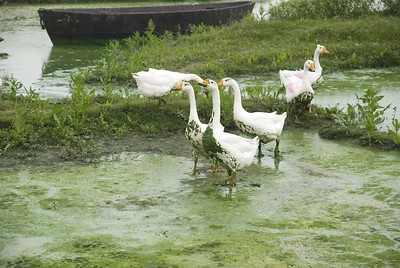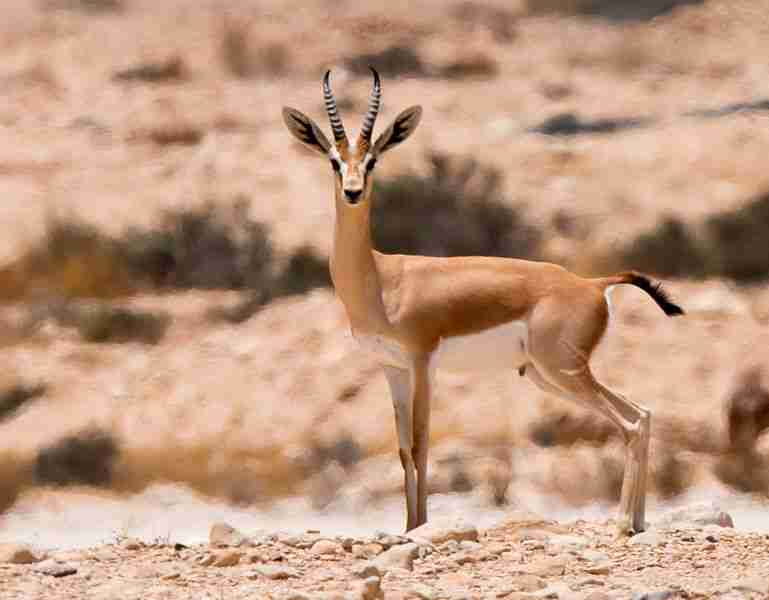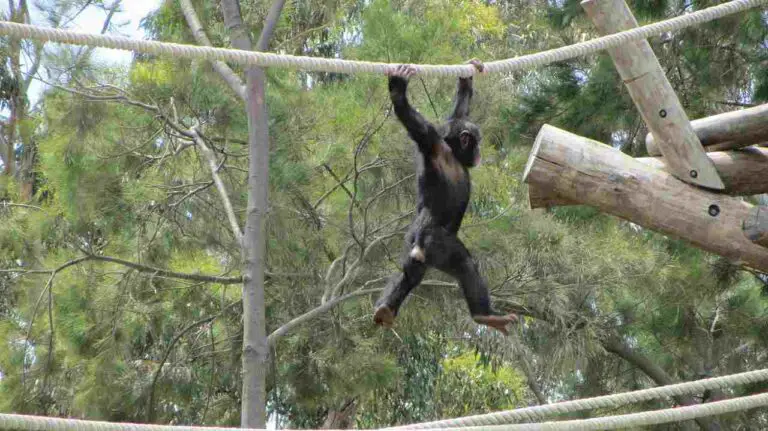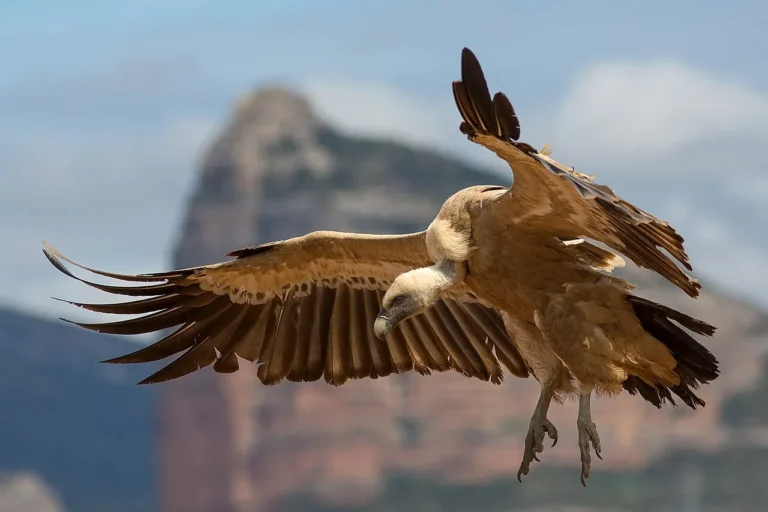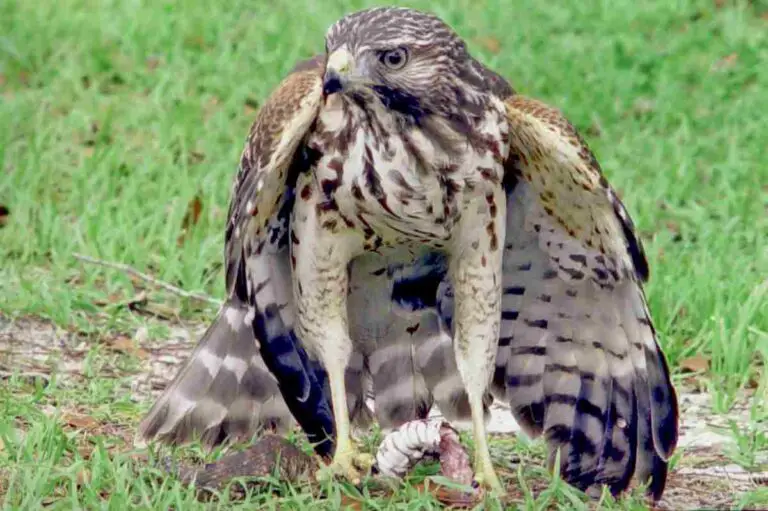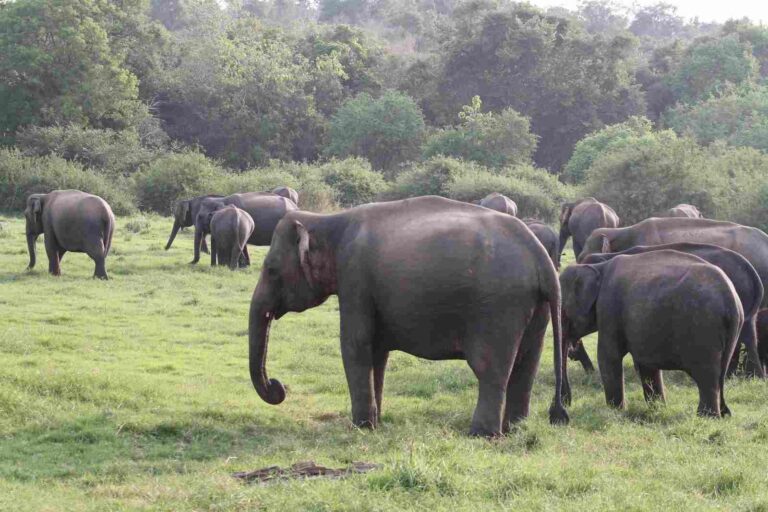All Snake Types With Characteristics and Examples Discussed
All snake type include; small snakes like Barbados Threadsnake, Brahminy Blindsnake, medium-sized snakes like Corn Snake, Garter Snake, Rat Snake, King Snake, Milk Snake, large constrictor snakes like Burmese Python, Reticulated Python, Anaconda, Boa Constrictor, Green Anaconda, large venomous snakes like Black Mamba, Taipan, Coral Snake, Saw-scaled Viper, Boomslang, and large non-constrictor snakes like King Cobra, Coastal Taipan, Inland Taipan, Mangrove Snake.
This article discusses all snake types along with their examples, as follows;
I). Small Snakes
1. Barbados Threadsnake:
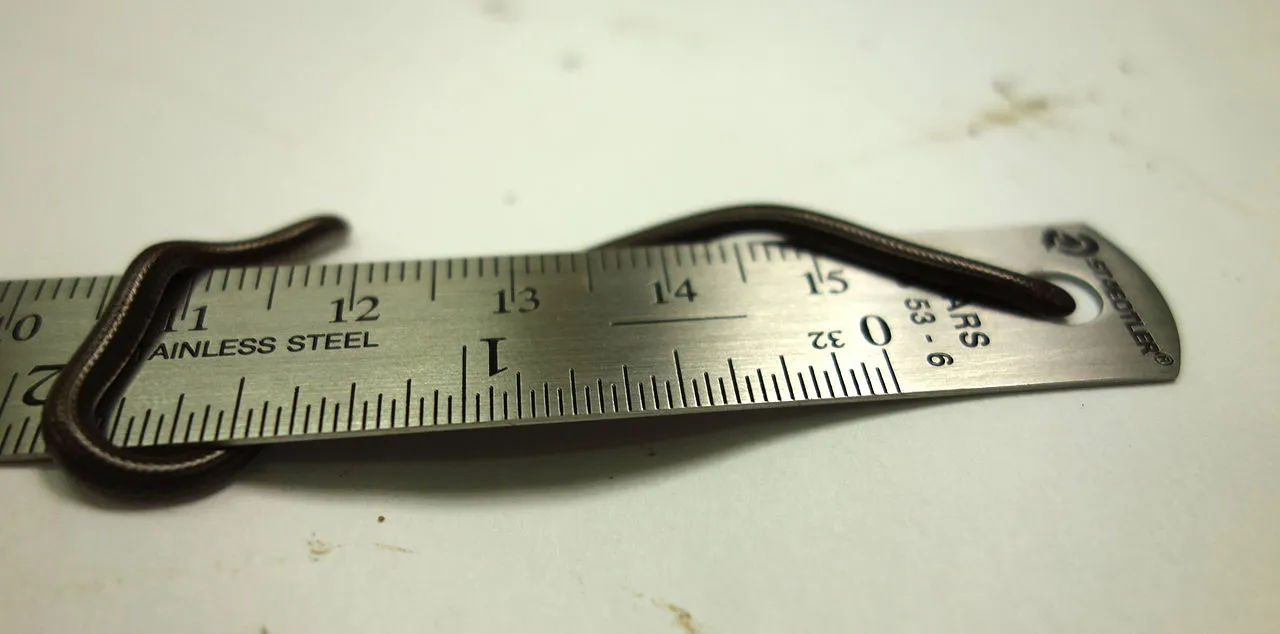
Physical Features:
One of the smallest snakes in the world, typically measuring around 4 inches in length.
Slender body with a pointed snout.
Smooth scales and typically brown or grayish-brown in color.
Behavioral Characteristics:
Nocturnal and secretive, spending most of their time underground.
Primarily feed on ant and termite larvae.
Rarely seen due to their small size and secretive nature.
Ecological Roles:
Play a role in controlling insect populations, especially ants and termites, in their habitat.
Serve as prey for larger predators in the ecosystem.
Limited distribution in Barbados, making them a unique component of the island’s biodiversity.
2. Brahminy Blindsnake:
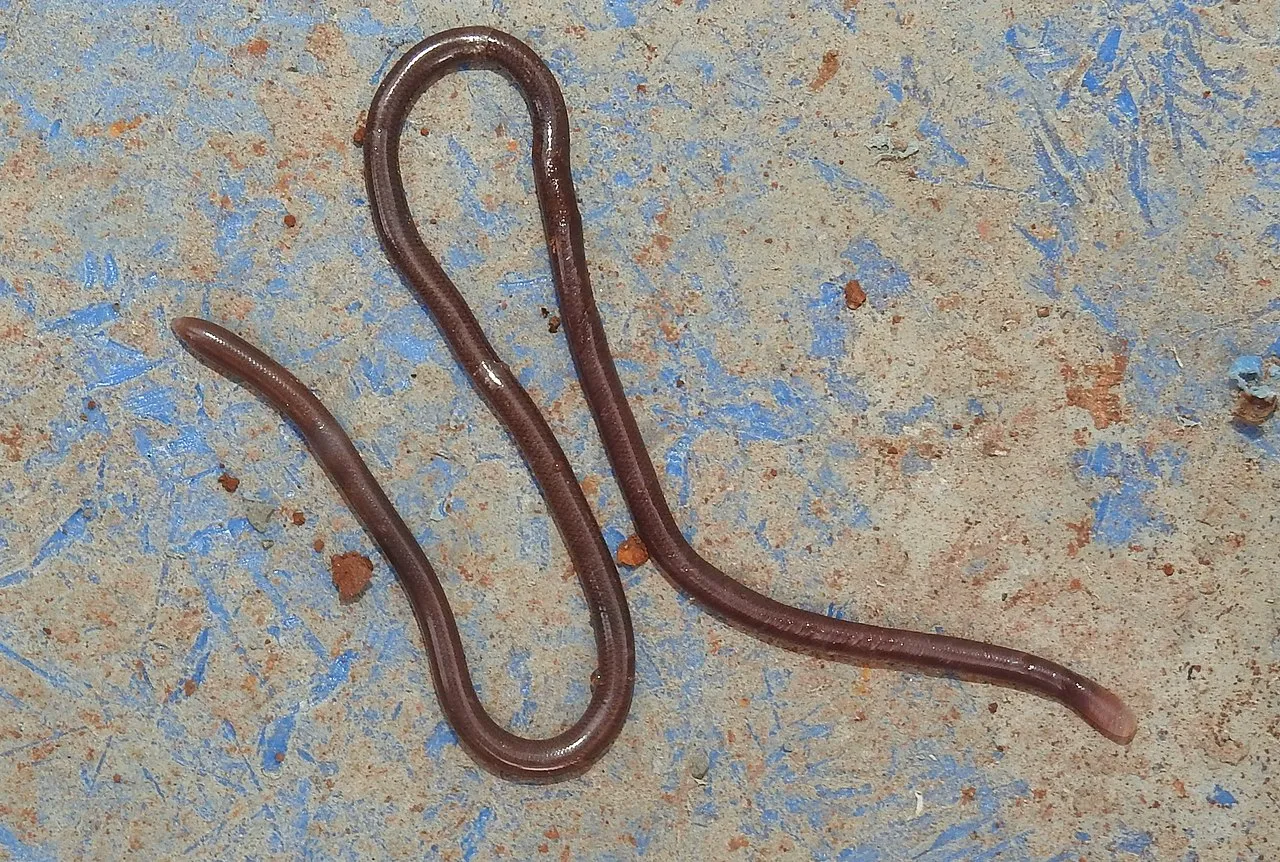
Physical Features:
Very small, worm-like appearance with smooth shiny scales.
Typically dark brown or black in color.
Eyes greatly reduced or even absent, giving them the name “blindsnake.”
Behavioral Characteristics:
Nocturnal and fossorial, spending much of their time burrowing underground.
Primarily feed on ant and termite larvae.
Non-venomous and harmless to humans.
Ecological Roles:
Help control insect populations, particularly ants and termites.
Serve as prey for various predators in their ecosystem.
3. Ringneck Snake:
Physical Features:
Small, slender snake with smooth scales.
Named for the distinct ring around its neck, which is usually yellow or orange.
Colors vary but often include shades of gray, brown, or black.
Behavioral Characteristics:
Nocturnal and secretive, often found hiding under rocks or debris.
Primarily feeds on small invertebrates such as earthworms, slugs, and insects.
Non-venomous and generally docile, rarely biting unless threatened.
Ecological Roles:
Play a role in controlling populations of small invertebrates.
Serve as prey for larger predators such as birds, mammals, and other snakes.
4. Sharp-tailed Snake:
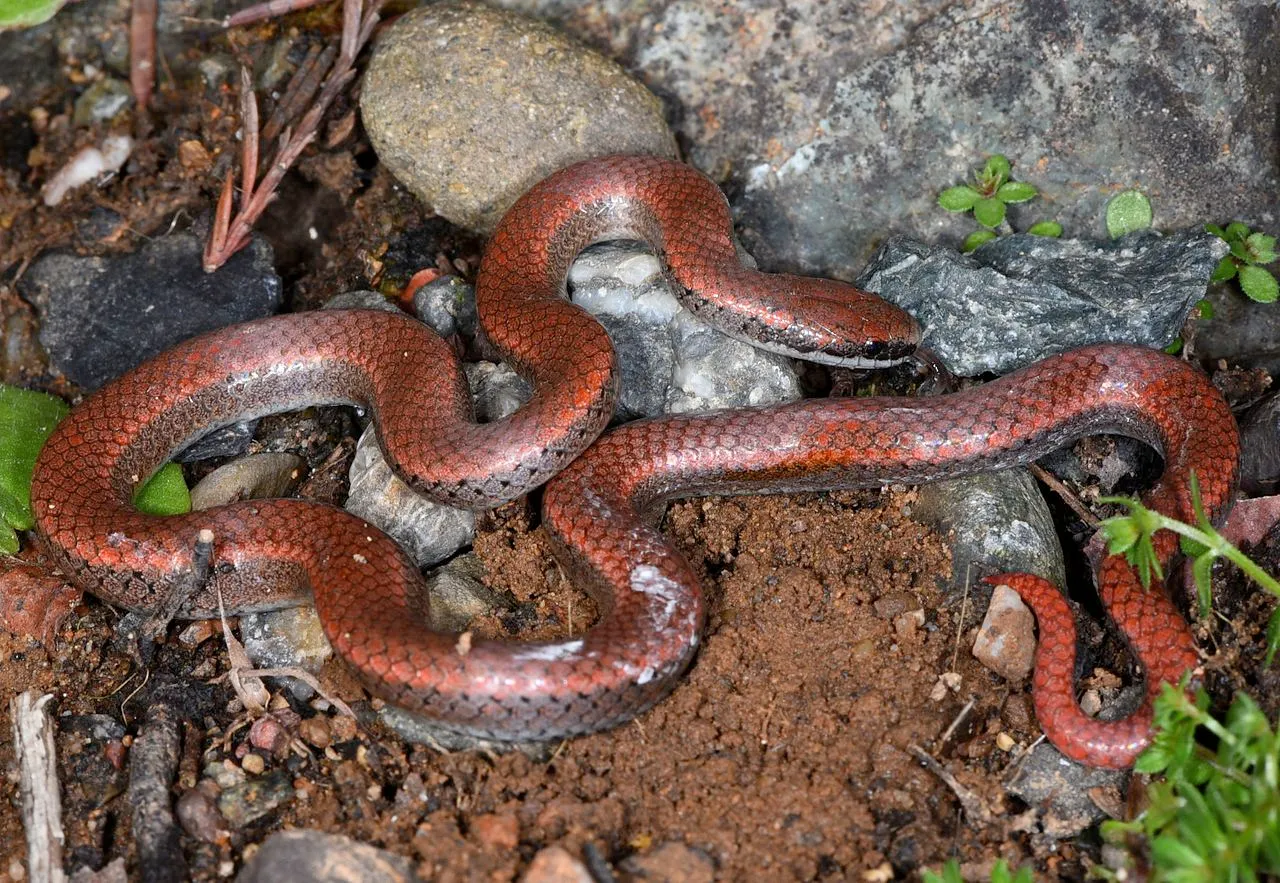
Physical Features:
Small, slender snake with a pointed tail.
Typically brown or grayish-brown with lighter markings on the belly.
Smooth scales and a distinctive head shape.
Behavioral Characteristics:
Nocturnal and secretive, often found hiding under debris or leaf litter.
Primarily feeds on small invertebrates such as slugs, worms, and insects.
Non-venomous and rarely bites humans.
Ecological Roles:
Help control populations of small invertebrates in their habitat.
Serve as prey for larger predators such as birds, mammals, and other snakes.
5. Western Worm Snake:
Physical Features:
Small, slender snake with a worm-like appearance.
Typically brown or grayish-brown in color.
Smooth scales and a pointed snout.
Behavioral Characteristics:
Nocturnal and fossorial, spending much of their time burrowing underground.
Primarily feeds on earthworms and other soft-bodied invertebrates.
Non-venomous and harmless to humans.
Ecological Roles:
Help control populations of earthworms and other invertebrates.
Serve as prey for various predators in their ecosystem.
II). Medium-Sized Snakes
6. Corn Snake:
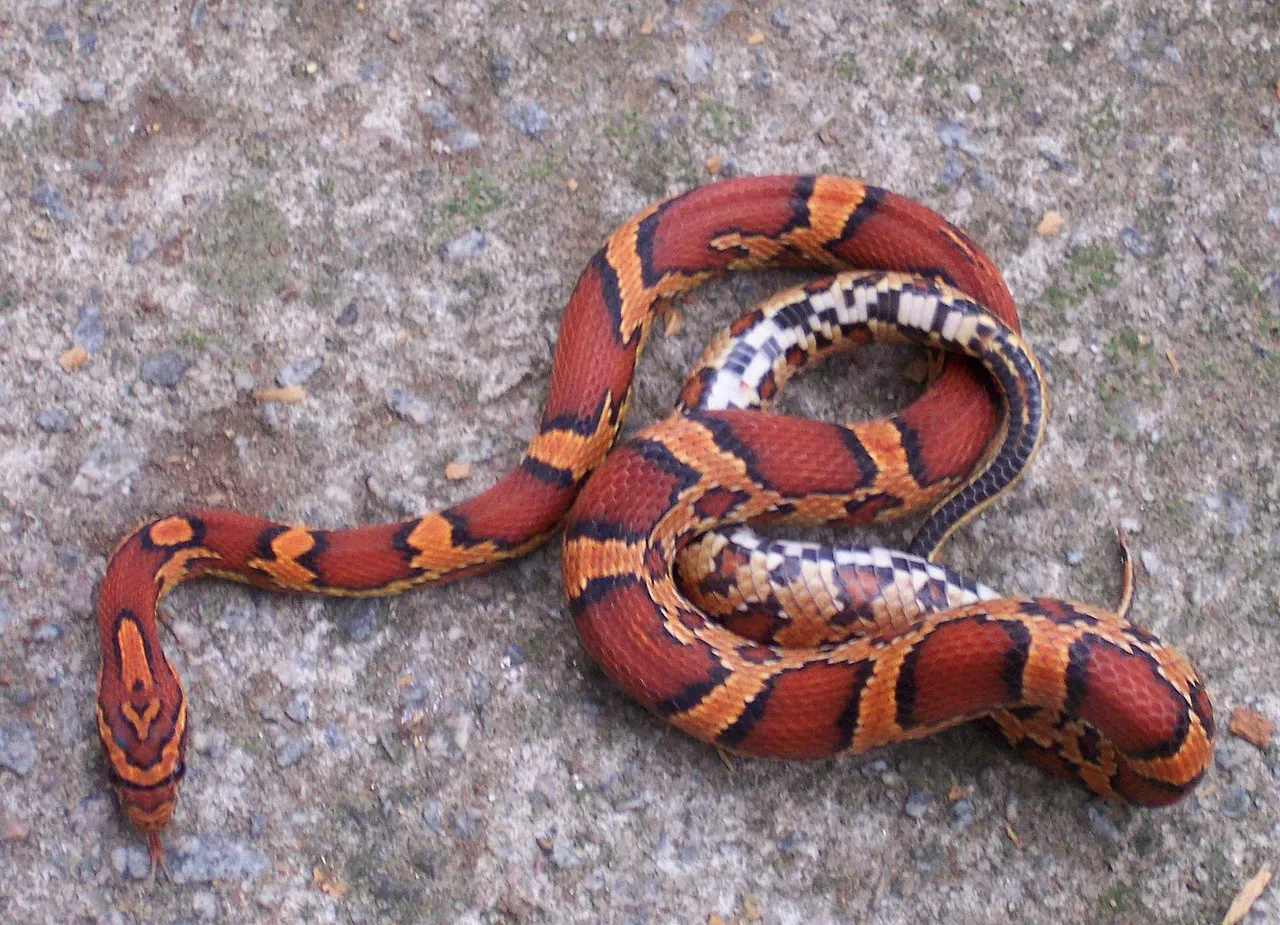
Physical Features:
Medium-sized snake with vibrant coloration and patterns.
Typically orange or reddish-brown with black-bordered red blotches.
Smooth scales and a distinct pattern of large, blotchy markings.
Behavioral Characteristics:
Nocturnal and semi-arboreal, often found climbing in trees or hiding in rock crevices.
Primarily feeds on small mammals, birds, and their eggs.
Non-venomous and docile, making them popular as pets.
Ecological Roles:
Play a role in controlling populations of small mammals and birds.
Also serve as prey for larger predators such as birds of prey and mammals.
7. Garter Snake:
Physical Features:
Medium-sized snake with a slender body and distinctive longitudinal stripes.
Coloration varies but often includes combinations of green, brown, yellow, or black.
Typically found near water sources such as streams, ponds, or marshes.
Behavioral Characteristics:
Diurnal and semi-aquatic, often seen basking in the sun near water.
Feed on a variety of prey including amphibians, fish, insects, and small rodents.
Non-venomous but may release a foul-smelling musk when threatened.
Ecological Roles:
Play a role in controlling populations of amphibians, fish, and small rodents.
Serve as prey for various predators in their ecosystem.
8. Rat Snake:
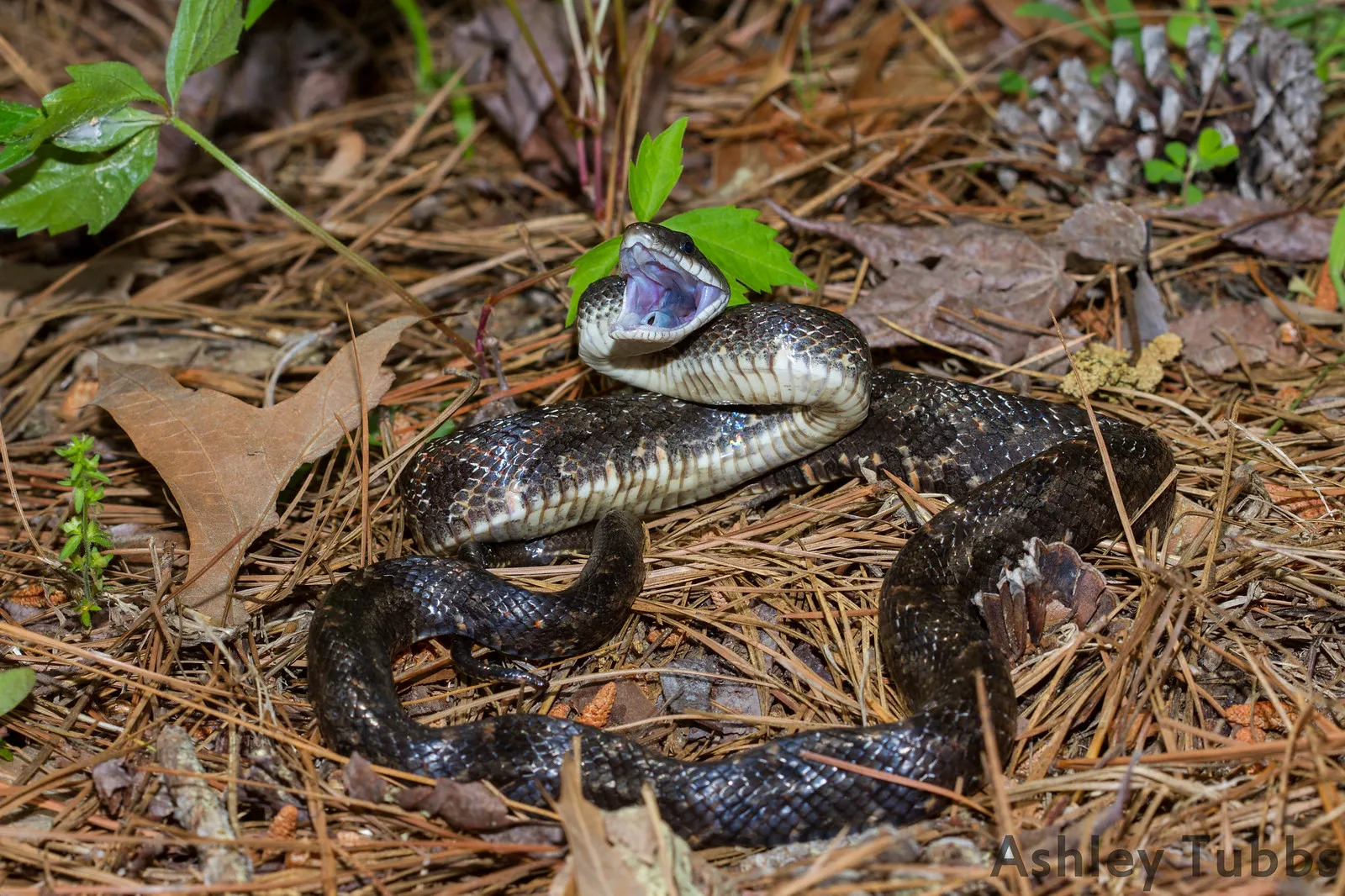
Physical Features:
Medium to large-sized snake with a slender body and keeled scales.
Coloration varies but often includes shades of brown, gray, or black with patterns of stripes or blotches.
Agile climbers and proficient hunters.
Behavioral Characteristics:
Nocturnal or crepuscular, often active during the evening or early morning.
Feed primarily on rodents but also consume birds, eggs, and other small mammals.
Non-venomous and usually docile, although they may strike if threatened.
Ecological Roles:
Important predators of rodent populations, helping to control their numbers.
Serve as prey for larger predators such as birds of prey and mammals.
9. King Snake:
Physical Features:
Medium-sized snake with a glossy appearance and bold patterns.
Typically black or dark brown with white or yellow bands or rings.
Thick-bodied with smooth scales and a distinctive head shape.
Behavioral Characteristics:
Diurnal and terrestrial, often found in a variety of habitats including forests, grasslands, and deserts.
Feed on a wide range of prey including rodents, birds, eggs, and other snakes, including venomous species.
Non-venomous and known for their immunity to the venom of many venomous snakes.
Ecological Roles:
Important predators of rodents and other small mammals.
Help control populations of venomous snakes in their habitat.
Serve as prey for larger predators such as birds of prey and mammals.
10. Milk Snake:
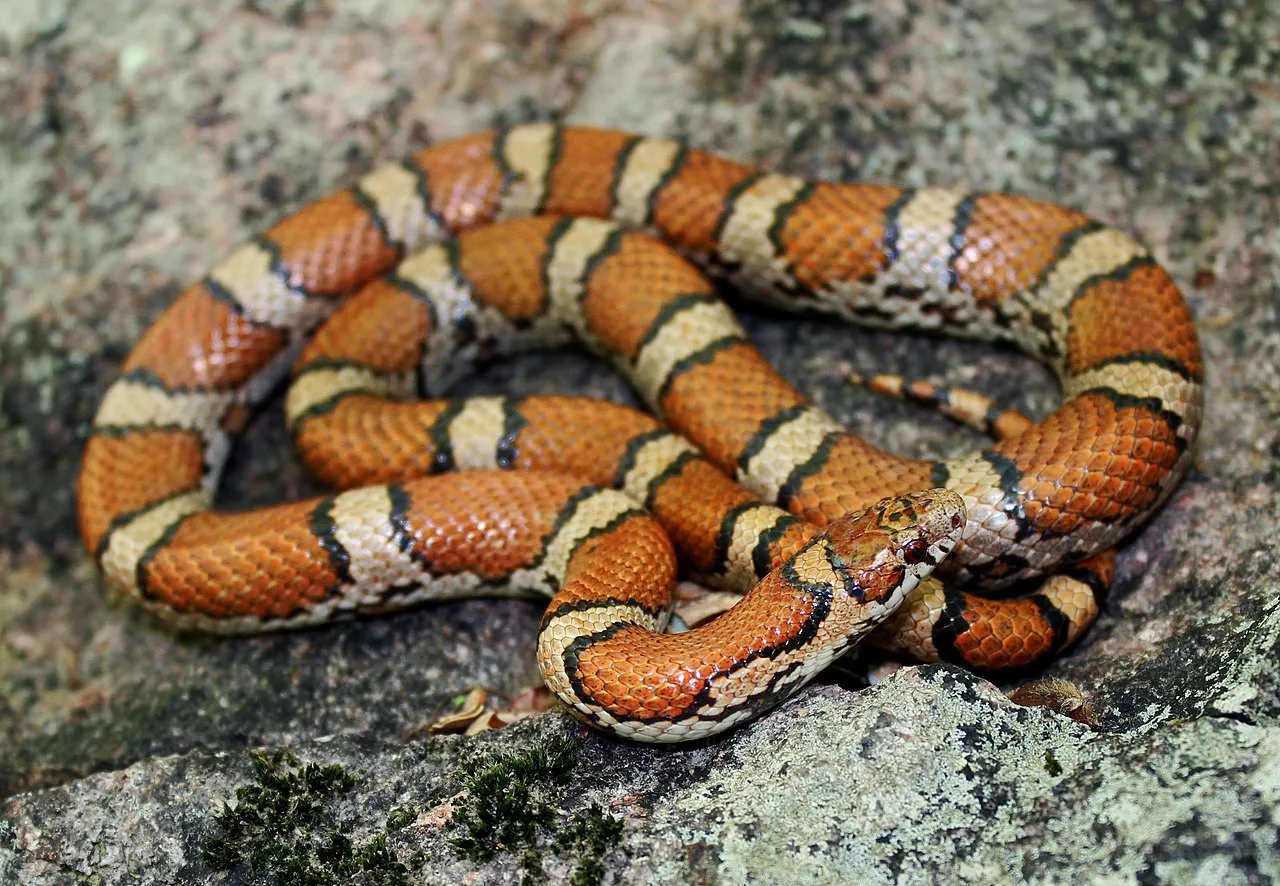
Physical Features:
Medium-sized snake with smooth scales and a slender body.
Typically marked with bands of red, black, and yellow or white, resembling the coloration of the venomous coral snake.
Often mistaken for coral snakes but can be distinguished by the order of their colored bands: red touches black, friend of Jack; red touches yellow, kills a fellow.
Behavioral Characteristics:
Nocturnal or crepuscular, often active during the evening or early morning.
Feed primarily on small mammals, birds, eggs, and amphibians.
Non-venomous and generally docile, rarely biting humans.
Ecological Roles:
Play a role in controlling populations of small mammals, birds, and amphibians.
Serve as prey for larger predators such as birds of prey and mammals.
III). Large Snakes
11. Burmese Python:
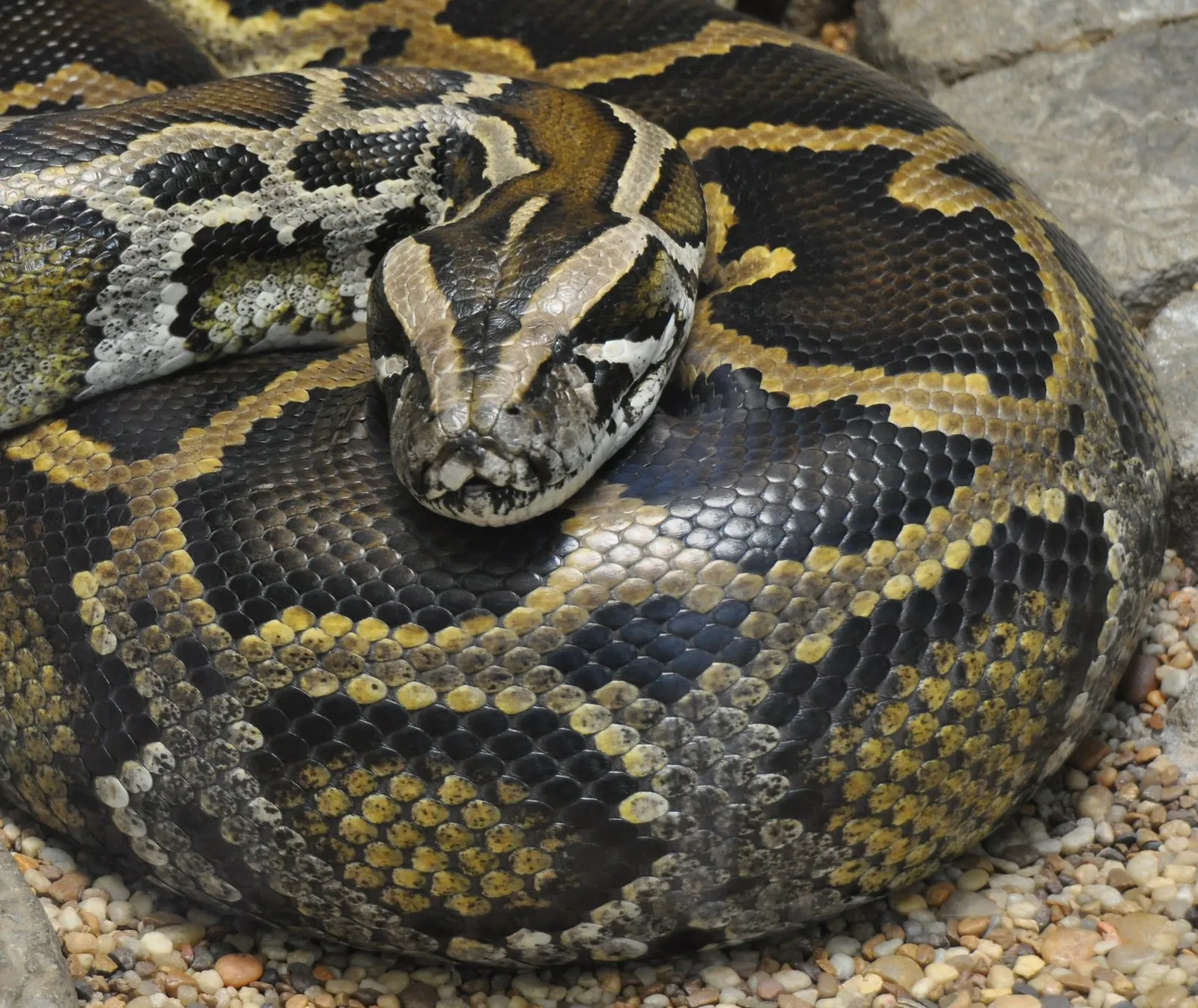
Physical Features:
Large-bodied snake with smooth scales and a distinctive pattern of dark blotches on a lighter background.
Can reach lengths of over 20 feet, making them one of the largest snake species in the world.
Native to Southeast Asia but widely distributed as an invasive species in Florida and other parts of the world.
Behavioral Characteristics:
Nocturnal and terrestrial, often found in a variety of habitats including forests, marshes, and agricultural areas.
Feed primarily on mammals, birds, and other vertebrates, often swallowing prey whole.
Non-venomous but capable of delivering a powerful constricting squeeze to subdue prey.
Ecological Roles:
Considered invasive in many regions, where they can have significant impacts on native wildlife populations.
Compete with native predators for food and habitat resources.
Predators of a wide range of vertebrate species, including small mammals and birds.
12. Reticulated Python:
Physical Features:
One of the longest snake species in the world, with individuals reaching lengths of over 20 feet.
Distinctive pattern of intricate geometric markings on a lighter background, resembling a net or mesh.
Native to Southeast Asia and widely kept in captivity for the exotic pet trade.
Behavioral Characteristics:
Nocturnal and terrestrial, often found in a variety of habitats including forests, grasslands, and agricultural areas.
Feed primarily on mammals, birds, and other vertebrates, often swallowing prey whole.
Non-venomous but capable of delivering a powerful constricting squeeze to subdue prey.
Ecological Roles:
Similar to the Burmese python, reticulated pythons can have significant impacts as invasive species in regions where they have been introduced.
Compete with native predators for food and habitat resources.
Predators of a wide range of vertebrate species, including small mammals and birds.
13. Anaconda:
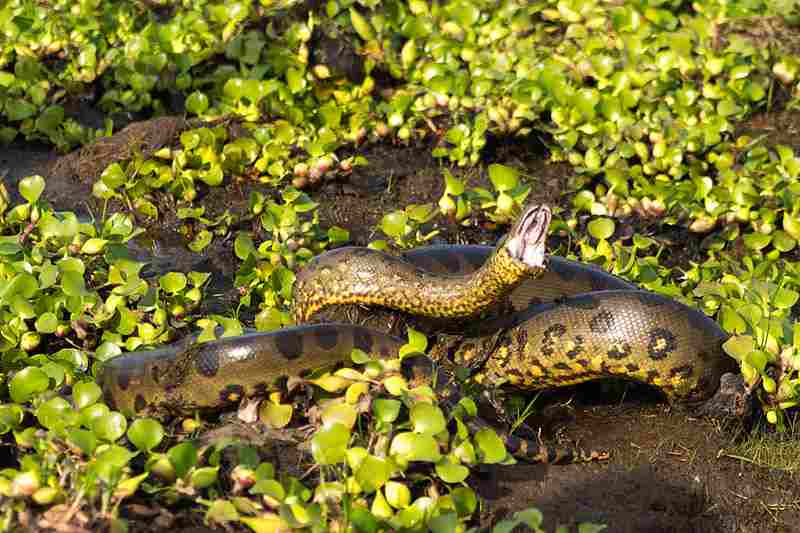
Physical Features:
Large, heavy-bodied snake with smooth scales and a dark green coloration.
Can reach lengths of over 25 feet and weigh several hundred pounds, making them one of the heaviest snake species in the world.
Found in tropical rainforests and swamps of South America.
Behavioral Characteristics:
Nocturnal and semi-aquatic, often found in or near water bodies such as rivers, lakes, and swamps.
Feed primarily on aquatic prey such as fish, amphibians, and aquatic mammals.
Non-venomous but capable of delivering a powerful constricting squeeze to subdue prey.
Ecological Roles:
Important predators in their ecosystems, helping to control populations of aquatic prey species.
Serve as apex predators in their habitat, with few natural predators aside from humans.
Play a role in nutrient cycling and ecosystem dynamics through their feeding habits and interactions with other species.
14. Boa Constrictor:
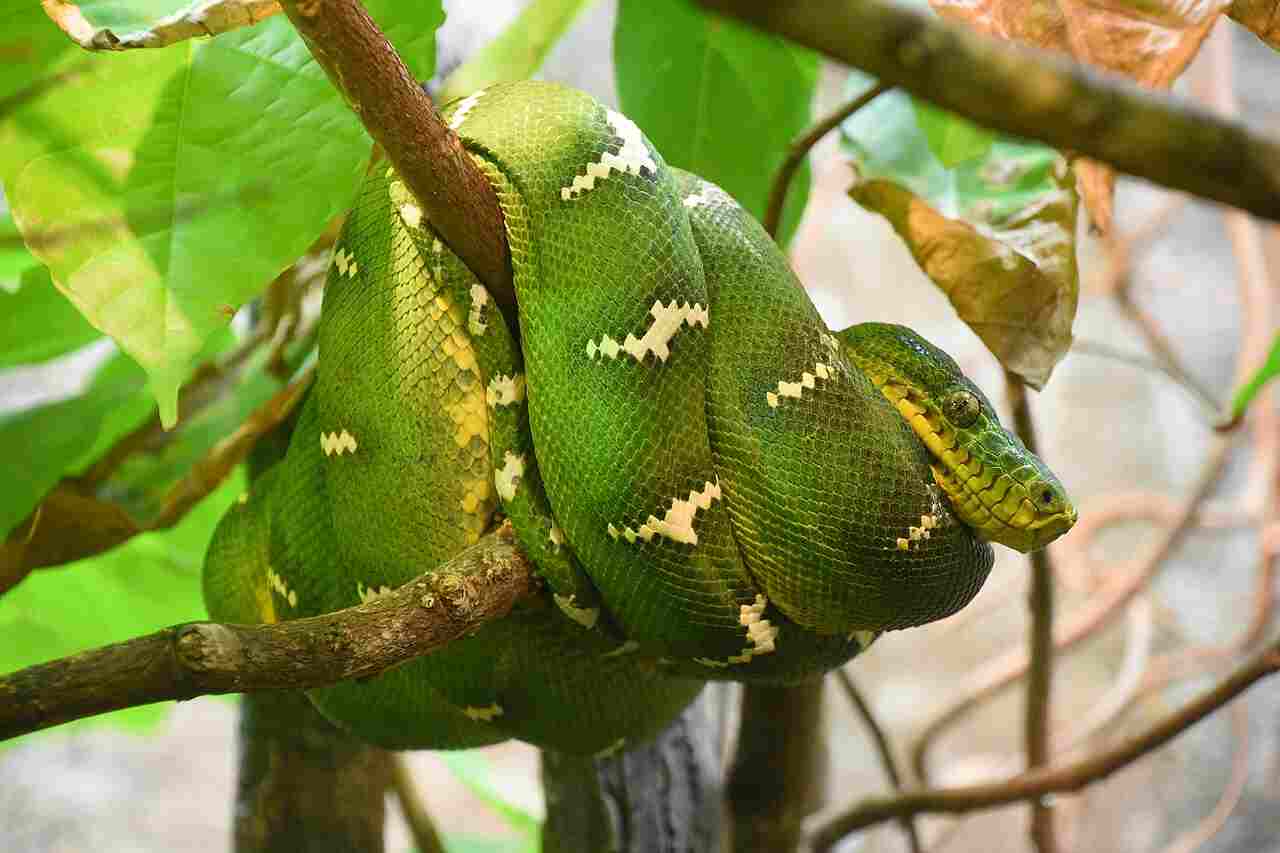
Physical Features:
Large, heavy-bodied snake with smooth scales and a variety of color patterns, including shades of brown, tan, and gray.
Typically have distinctive markings such as saddles or blotches along their back.
Can reach lengths of up to 13 feet or more.
Behavioral Characteristics:
Nocturnal and terrestrial, often found in a variety of habitats including forests, grasslands, and tropical rainforests.
Feed primarily on small to medium-sized mammals, birds, and reptiles, which they kill by constriction.
Non-venomous but capable of delivering a powerful constricting squeeze to subdue prey.
Ecological Roles:
Important predators in their ecosystems, helping to control populations of small mammals, birds, and reptiles.
Serve as prey for larger predators such as jaguars, birds of prey, and large snakes.
15. Green Anaconda:
Physical Features:
One of the largest and heaviest snake species in the world, with individuals reaching lengths of over 20 feet and weighing several hundred pounds.
Dark green coloration with black spots or markings along the body.
Found in tropical rainforests and swamps of South America, particularly the Amazon Basin.
Behavioral Characteristics:
Nocturnal and semi-aquatic, often found in or near water bodies such as rivers, lakes, and swamps.
Feed primarily on aquatic prey such as fish, amphibians, and aquatic mammals, which they capture and kill by constriction.
Non-venomous but capable of delivering a powerful constricting squeeze to subdue prey.
Ecological Roles:
Serve as apex predators in their habitat, playing a key role in controlling populations of aquatic prey species.
Can impact ecosystem dynamics through their feeding habits and interactions with other species.
Face threats from habitat loss, hunting for their skins, and conflicts with humans.
IV). Venomous Snakes
16. Black Mamba:
Physical Features:
Large, slender snake with smooth scales and typically olive to grayish-brown in color.
Can reach lengths of up to 14 feet, making them one of the longest venomous snakes in Africa.
Mouth interior is black, giving them their name.
Behavioral Characteristics:
Diurnal and terrestrial, often found in a variety of habitats including savannas, woodlands, and rocky areas.
Highly venomous, with neurotoxic venom that can be fatal to humans if not treated promptly.
Fast-moving and agile, capable of striking repeatedly and delivering potent venom.
Ecological Roles:
Apex predators in their ecosystems, playing a key role in controlling populations of small mammals and birds.
Face threats from habitat loss, persecution by humans, and conflict with livestock.
17. Taipan:
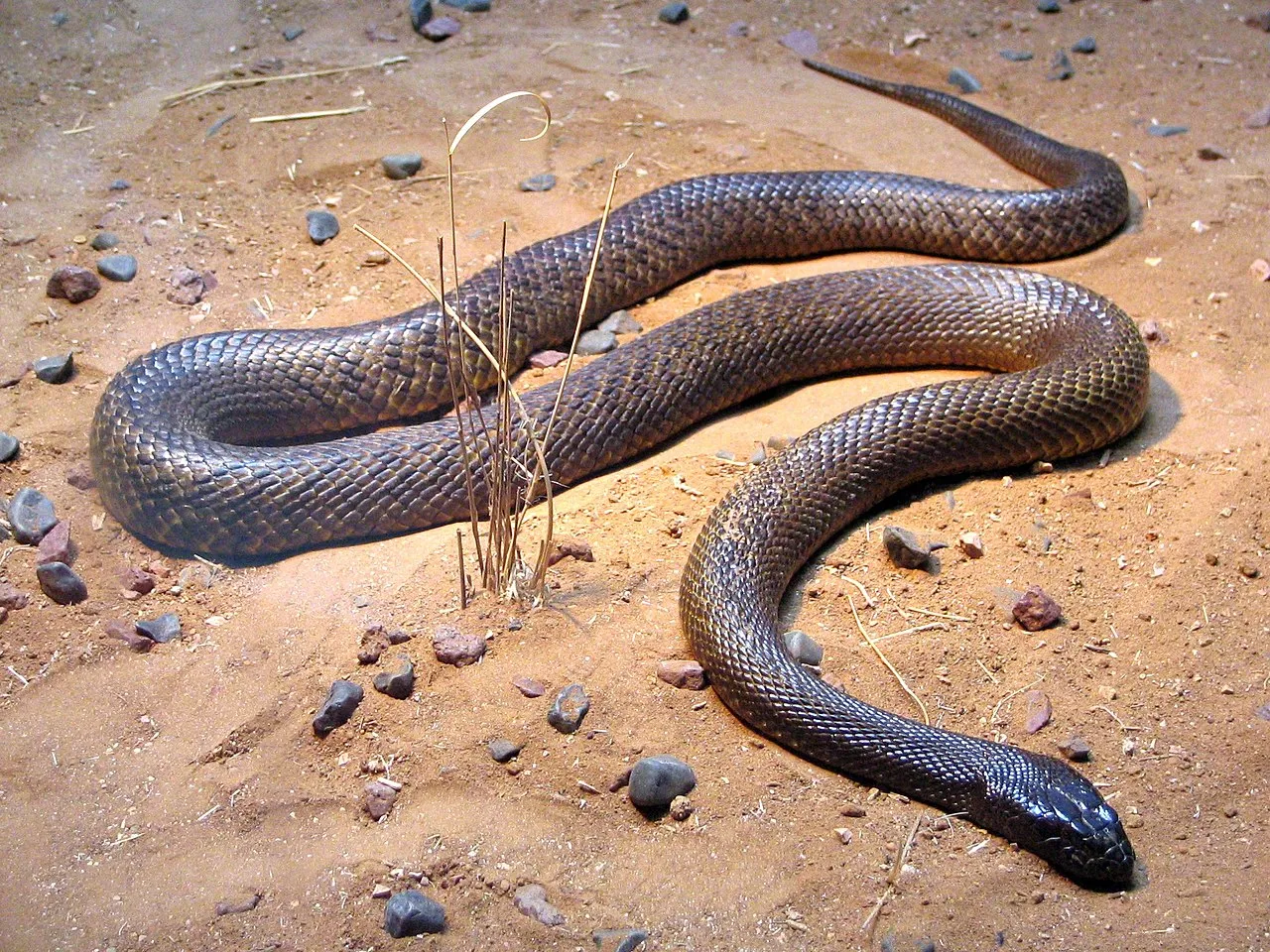
Physical Features:
Large, fast-moving snake with smooth scales and typically olive to brown in color.
Can reach lengths of up to 8 feet or more.
Found in various habitats including grasslands, woodlands, and rocky areas in Australia and Papua New Guinea.
Behavioral Characteristics:
Diurnal and terrestrial, often active during the day.
Highly venomous, with potent neurotoxic venom that can be fatal to humans if not treated promptly.
Fast-moving and capable of striking with great accuracy over a considerable distance.
Ecological Roles:
Important predators in their ecosystems, helping to control populations of small mammals and birds.
Face threats from habitat loss, persecution by humans, and conflict with livestock.
18. Coral Snake:
Physical Features:
Small to medium-sized venomous snake with a slender body and smooth scales.
Typically have distinctive bands of red, yellow, and black or white encircling the body.
Often have a black snout and round pupils.
Behavioral Characteristics:
Nocturnal and secretive, often hiding under leaf litter or debris during the day.
Feed primarily on small vertebrates such as lizards, frogs, and other snakes.
Have potent neurotoxic venom, but they are not aggressive and usually only bite in self-defense.
Ecological Roles:
Play a role in controlling populations of small vertebrates in their habitat.
Serve as prey for larger predators such as birds of prey and mammals.
19. Saw-scaled Viper:
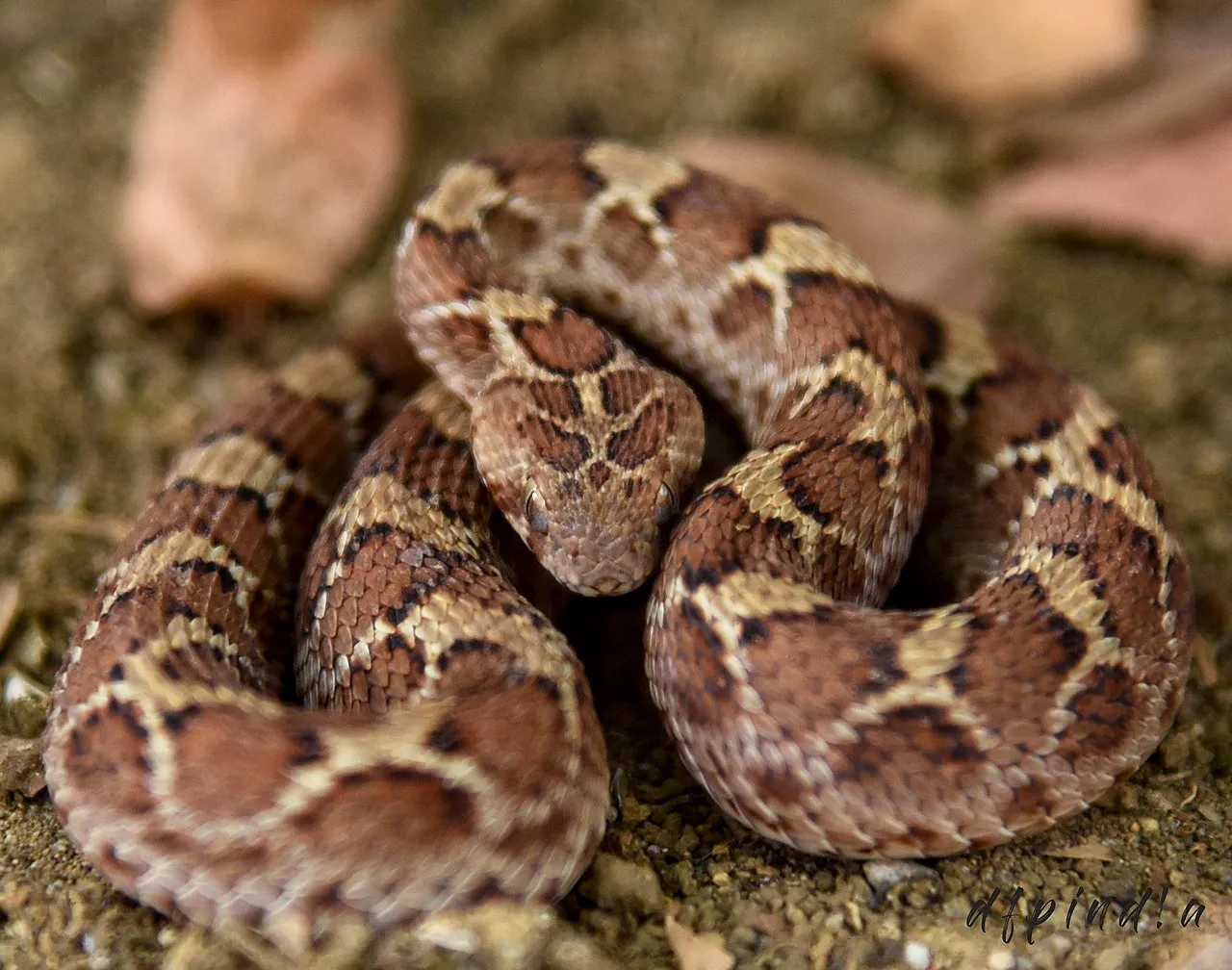
Physical Features:
Small to medium-sized venomous snake with a stout body and keeled scales.
Typically have a distinctive saw-like ridge along the edge of their scales, which they rub together to produce a rasping sound when threatened.
Coloration varies but often includes shades of brown, gray, or reddish-brown.
Behavioral Characteristics:
Nocturnal and terrestrial, often found in a variety of habitats including deserts, grasslands, and rocky areas.
Feed primarily on small mammals, birds, and lizards.
Have potent cytotoxic venom, causing tissue damage and sometimes death if not treated promptly.
Ecological Roles:
Important predators in their ecosystems, helping to control populations of small vertebrates.
Face threats from habitat loss, persecution by humans, and conflict with livestock.
20. Boomslang:
Physical Features:
Medium-sized venomous snake with a slender body and smooth scales.
Typically have bright green coloration on the upper body and yellow or greenish-yellow coloration on the belly.
Eyes are large and bulging, giving them excellent vision.
Behavioral Characteristics:
Diurnal and arboreal, often found in trees and shrubs where they hunt for prey.
Feed primarily on small vertebrates such as birds, lizards, and tree frogs.
Have potent hemotoxic venom, causing internal bleeding and sometimes death if not treated promptly.
Ecological Roles:
Important predators in their ecosystems, particularly in forested areas.
Serve as prey for larger predators such as birds of prey and mammals.
V). Nonvenomous Snakes
21. Bullsnake:
Physical Features:
Large, heavy-bodied snake with smooth scales and a distinctive pattern of dark blotches or spots on a lighter background.
Typically have a pale or yellowish belly.
Can reach lengths of up to 6 feet or more.
Behavioral Characteristics:
Diurnal and terrestrial, often found in a variety of habitats including grasslands, deserts, and agricultural areas.
Feed primarily on small mammals, birds, and their eggs.
Non-venomous and known for their defensive behavior, including hissing loudly and vibrating their tail when threatened.
Ecological Roles:
Important predators in their ecosystems, helping to control populations of small mammals and birds.
Face threats from habitat loss, persecution by humans, and road mortality.
22. Pine Snake:
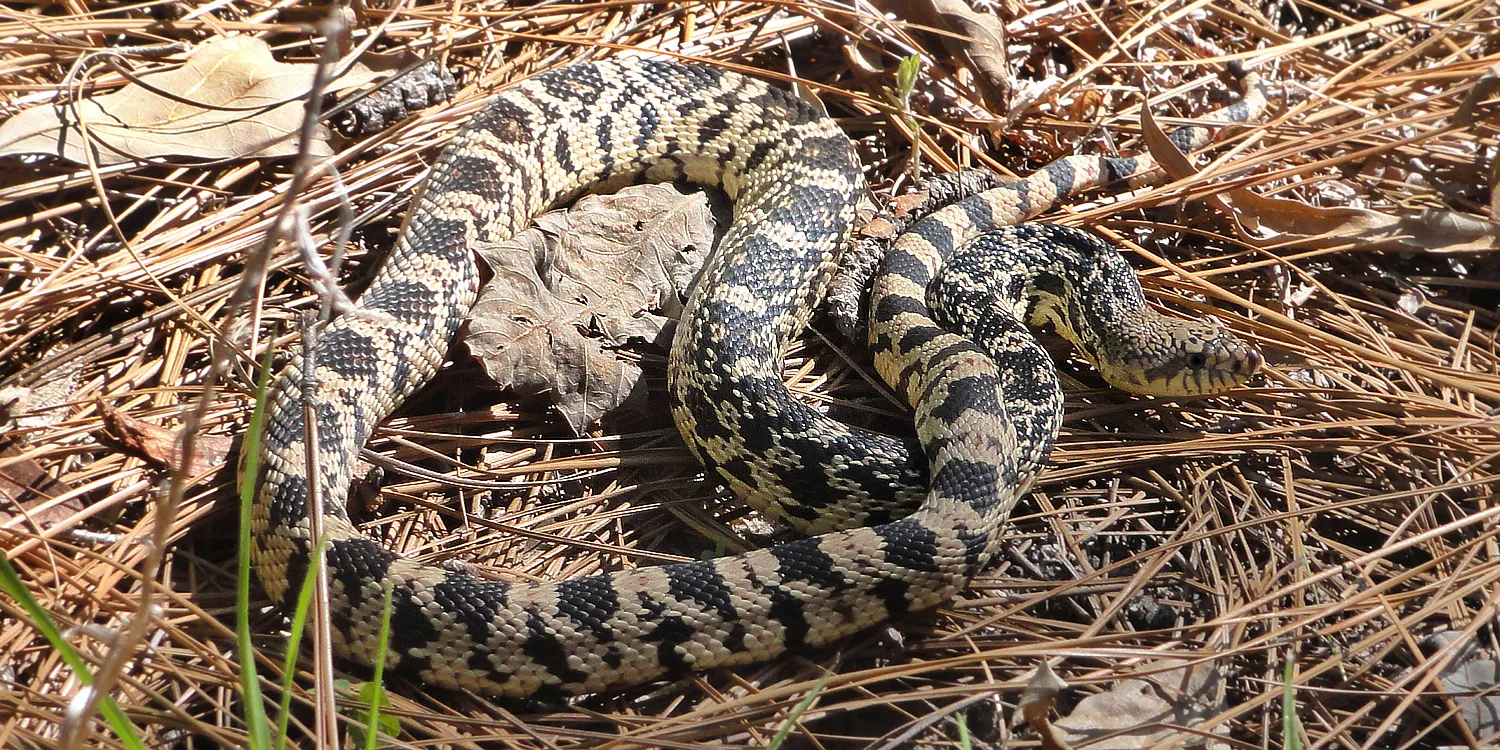
Physical Features:
Medium to large-sized snake with a stout body and smooth scales.
Typically have a pattern of dark blotches or spots on a lighter background, resembling pine cones, hence the name.
Colors vary but often include shades of brown, gray, or reddish-brown.
Behavioral Characteristics:
Diurnal and terrestrial, often found in a variety of habitats including pine forests, grasslands, and sandy areas.
Feed primarily on small mammals, birds, and their eggs.
Non-venomous and known for their defensive behavior, including hissing loudly and vibrating their tail when threatened.
Ecological Roles:
Important predators in their ecosystems, helping to control populations of small mammals and birds.
Play a role in maintaining ecosystem balance and biodiversity.
23. Rubber Boa:
Physical Features:
Small to medium-sized snake with a stout body and smooth, rubbery-looking scales.
Typically have a uniform brown or olive coloration, blending in with their surroundings.
Short tail and blunt head, giving them a distinctive appearance.
Behavioral Characteristics:
Nocturnal and terrestrial, often found in a variety of habitats including forests, grasslands, and rocky areas.
Feed primarily on small mammals, birds, and their eggs.
Non-venomous and known for their gentle demeanor, rarely biting even when threatened.
Ecological Roles:
Play a role in controlling populations of small mammals and birds.
Serve as prey for larger predators such as birds of prey and mammals.
24. Ribbon Snake:
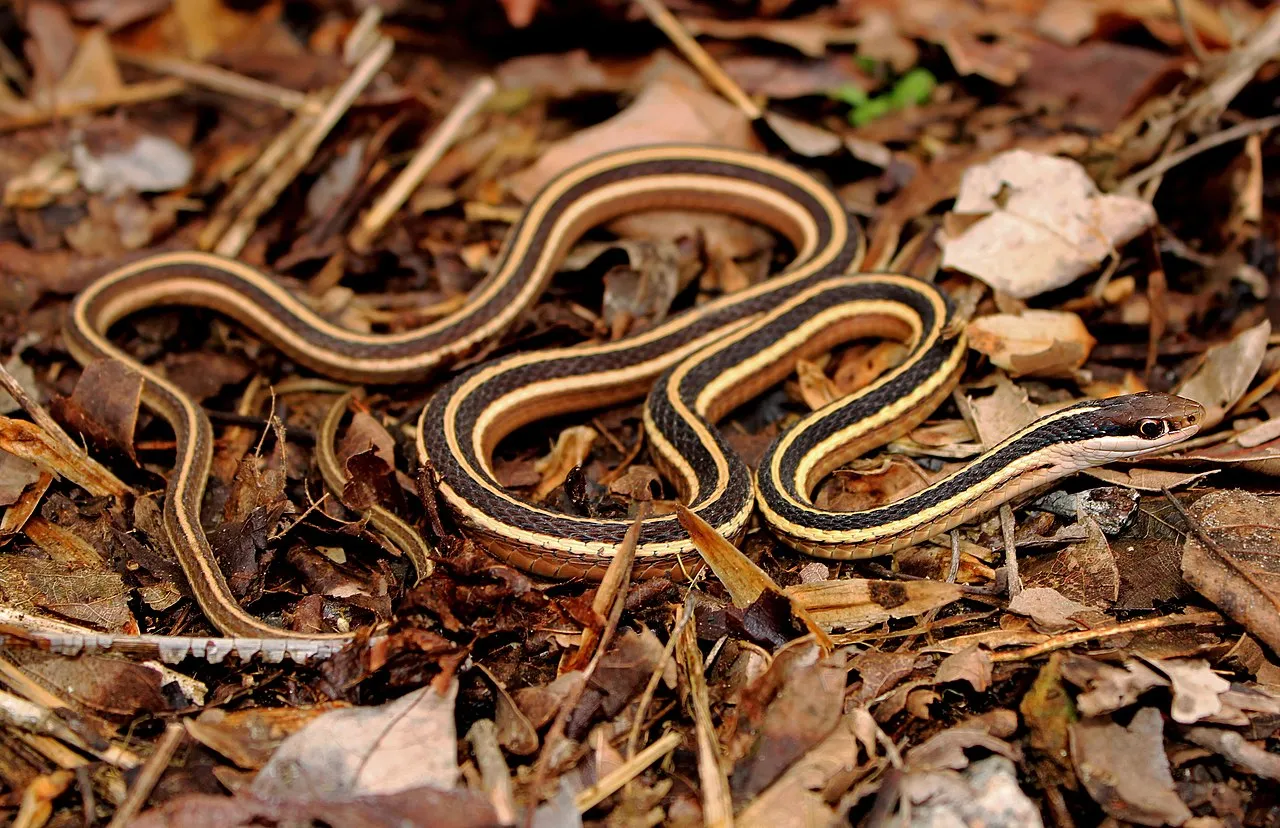
Physical Features:
Small to medium-sized snake with a slender body and smooth scales.
Typically have a distinctive pattern of longitudinal stripes running along the body.
Colors vary but often include shades of black, green, yellow, or brown.
Behavioral Characteristics:
Diurnal and semi-aquatic, often found near water bodies such as streams, ponds, and marshes.
Feed primarily on small fish, tadpoles, frogs, and aquatic invertebrates.
Non-venomous and known for their agility and ability to escape into water when threatened.
Ecological Roles:
Important predators in aquatic ecosystems, helping to control populations of small fish and amphibians.
Serve as prey for larger predators such as birds of prey and mammals.
25. Rough Green Snake:
Physical Features:
Small to medium-sized snake with a slender body and rough scales.
Typically bright green in color, blending in with vegetation in their habitat.
Long tail and large eyes, giving them excellent vision.
Behavioral Characteristics:
Diurnal and arboreal, often found in trees and shrubs where they hunt for prey.
Feed primarily on small insects such as crickets, grasshoppers, and caterpillars.
Non-venomous and known for their gentle demeanor, rarely biting even when handled.
Ecological Roles:
Play a role in controlling populations of small insects in their habitat.
Serve as prey for birds of prey and other predators in their ecosystem.
VI). Constrictor Snakes
26. Emerald Tree Boa:
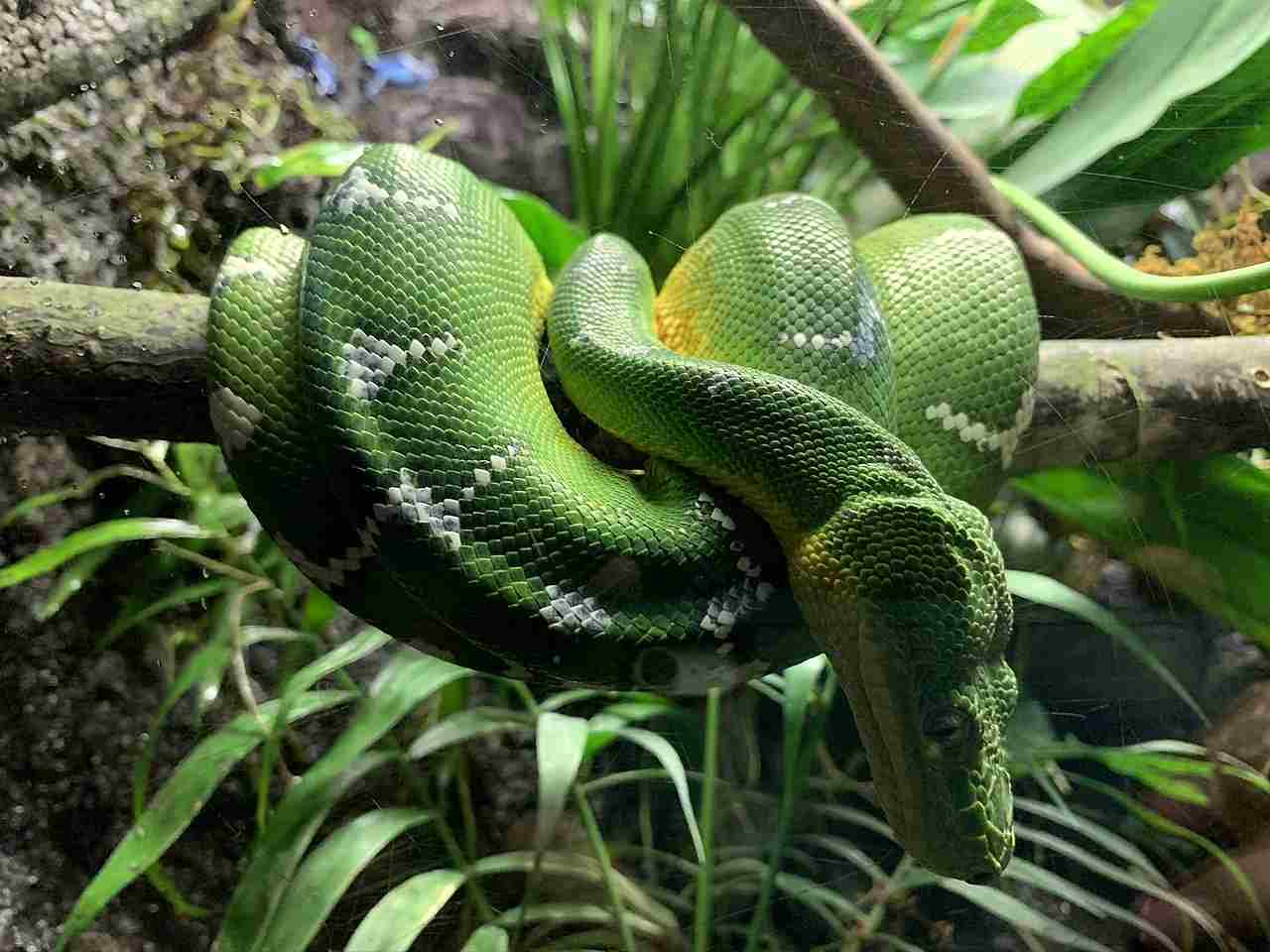
Physical Features:
Medium-sized snake with a slender body and highly arboreal habits.
Typically bright green in color with white or yellow markings, providing excellent camouflage in forested environments.
Have large eyes with vertical pupils and long, sharp teeth.
Behavioral Characteristics:
Nocturnal and arboreal, spending much of their time in trees where they hunt for prey.
Feed primarily on small mammals, birds, and reptiles.
Non-venomous but use their sharp teeth to capture and subdue prey.
Ecological Roles:
Important predators in their ecosystems, helping to control populations of small vertebrates.
Serve as prey for larger predators such as birds of prey and large snakes.
27. Rainbow Boa:
Physical Features:
Medium-sized snake with a slender body and iridescent scales that give them a rainbow-like appearance.
Typically have a pattern of dark markings on a lighter background.
Found in tropical rainforests of South America.
Behavioral Characteristics:
Nocturnal and terrestrial, often found on the forest floor or in low vegetation.
Feed primarily on small mammals, birds, and reptiles.
Non-venomous and use constriction to subdue prey.
Ecological Roles:
Play a role in controlling populations of small vertebrates in their habitat.
Serve as prey for larger predators such as birds of prey and large snakes.
28. Dumeril’s Boa:
Physical Features:
Medium to large-sized snake with a stout body and smooth scales.
Typically have a pattern of dark markings on a lighter background, often resembling a series of saddles or blotches.
Native to Madagascar and nearby islands.
Behavioral Characteristics:
Nocturnal and terrestrial, often found in a variety of habitats including forests, grasslands, and rocky areas.
Feed primarily on small mammals, birds, and reptiles.
Non-venomous and use constriction to subdue prey.
Ecological Roles:
Important predators in their ecosystems, helping to control populations of small vertebrates.
Serve as prey for larger predators such as birds of prey and large snakes.
29. Madagascar Tree Boa:
Physical Features:
Medium-sized snake with a slender body and prehensile tail, adapted for climbing in trees.
Typically have a pattern of dark markings on a lighter background, often resembling a series of saddles or blotches.
Endemic to Madagascar.
Behavioral Characteristics:
Nocturnal and arboreal, spending much of their time in trees where they hunt for prey.
Feed primarily on small mammals, birds, and reptiles.
Non-venomous and use constriction to subdue prey.
Ecological Roles:
Important predators in Madagascar’s unique ecosystems, helping to control populations of small vertebrates.
Face threats from habitat loss and collection for the pet trade.
30. Northern Pine Snake:
Physical Features:
Medium to large-sized snake with a slender body and smooth scales.
Typically have a pattern of dark blotches or spots on a lighter background, resembling pine cones.
Found in pine forests and sandy habitats of eastern North America.
Behavioral Characteristics:
Diurnal and terrestrial, often found burrowing in sandy soils or basking in sunny areas.
Feed primarily on small mammals, birds, and their eggs.
Non-venomous and known for their docile temperament, rarely biting even when handled.
Ecological Roles:
Play a role in controlling populations of small mammals and birds in their habitat.
Serve as prey for larger predators such as birds of prey and mammals.
VII). Large, Non-Constrictor Snakes
31. King Cobra:
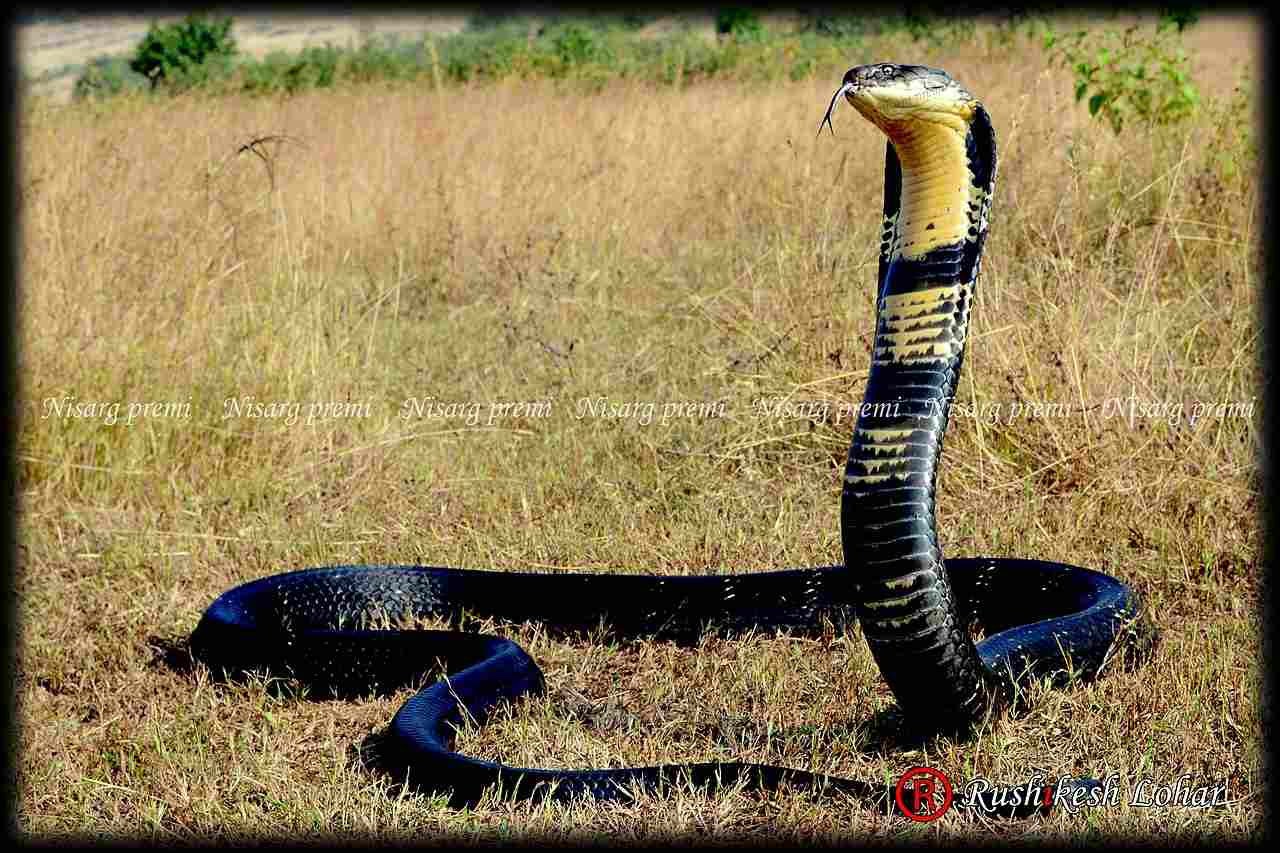
Physical Features:
Large, powerful snake with a slender body and distinctive hood when threatened.
Typically olive or tan in color with lighter bands or markings along the body.
Can reach lengths of up to 18 feet, making them the longest venomous snake species.
Behavioral Characteristics:
Diurnal and terrestrial, often found in a variety of habitats including forests, grasslands, and agricultural areas.
Feed primarily on other snakes, including venomous species, as well as small mammals and birds.
Highly venomous, with neurotoxic venom that can be fatal to humans if not treated promptly.
Ecological Roles:
Important predators in their ecosystems, helping to control populations of other snakes, particularly venomous species.
Serve as apex predators in their habitat, with few natural predators aside from humans.
32. Black Mamba:
Physical Features:
Large, slender snake with smooth scales and typically olive to grayish-brown in color.
Can reach lengths of up to 14 feet, making them one of the longest venomous snakes in Africa.
Mouth interior is black, giving them their name.
Behavioral Characteristics:
Diurnal and terrestrial, often found in a variety of habitats including savannas, woodlands, and rocky areas.
Highly venomous, with neurotoxic venom that can be fatal to humans if not treated promptly.
Fast-moving and agile, capable of striking repeatedly and delivering potent venom.
Ecological Roles:
Apex predators in their ecosystems, playing a key role in controlling populations of small mammals and birds.
Face threats from habitat loss, persecution by humans, and conflict with livestock.
33. Coastal Taipan:
Physical Features:
Medium to large-sized snake with a slender body and smooth scales.
Typically have a uniform brown or olive coloration.
Found in coastal regions of northern Australia.
Behavioral Characteristics:
Diurnal and terrestrial, often found in a variety of habitats including forests, grasslands, and coastal scrublands.
Feed primarily on small mammals, birds, and reptiles.
Highly venomous, with potent neurotoxic venom that can be fatal to humans if not treated promptly.
Ecological Roles:
Important predators in their ecosystems, helping to control populations of small vertebrates.
Face threats from habitat loss, persecution by humans, and conflict with livestock.
34. Inland Taipan:
Physical Features:
Medium-sized snake with a slender body and smooth scales.
Typically have a uniform brown or olive coloration, sometimes with darker markings along the body.
Found in arid and semi-arid regions of central Australia.
Behavioral Characteristics:
Diurnal and terrestrial, often found in a variety of habitats including deserts, grasslands, and rocky areas.
Feed primarily on small mammals, birds, and reptiles.
Highly venomous, with potent neurotoxic venom that is considered the most toxic of any snake species.
Ecological Roles:
Important predators in their ecosystems, helping to control populations of small vertebrates.
Face threats from habitat loss, persecution by humans, and conflict with livestock.
35. Mangrove Snake:
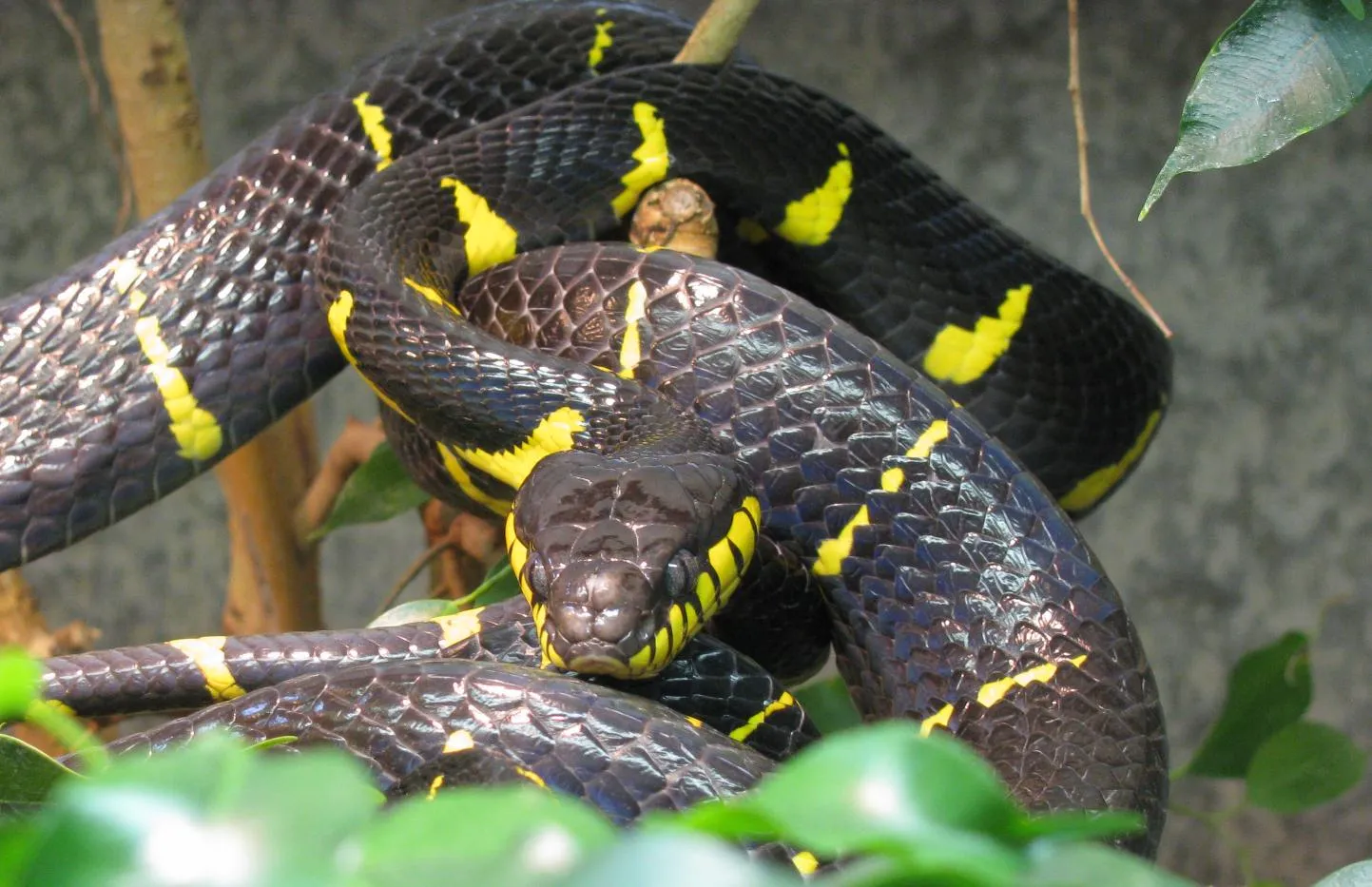
Physical Features:
Medium-sized snake with a slender body and smooth scales.
Typically have a pattern of dark bands or blotches on a lighter background, providing camouflage in mangrove habitats.
Found in mangrove forests and coastal wetlands of Southeast Asia and Australia.
Behavioral Characteristics:
Nocturnal and semi-arboreal, often found climbing in trees or hiding in mangrove roots.
Feed primarily on small vertebrates such as fish, frogs, and small mammals.
Non-venomous and use constriction to subdue prey.
Ecological Roles:
Play a role in controlling populations of small vertebrates in mangrove ecosystems.
Serve as prey for larger predators such as birds of prey and mammals.
36. Gaboon Viper:
Physical Features:
Large, heavy-bodied snake with a broad triangular head and distinctive pattern of geometric markings.
Typically have a beige or brown coloration with dark brown or black markings edged in lighter colors.
Found in forests and wooded areas of central and tropical Africa.
Behavioral Characteristics:
Nocturnal and terrestrial, often found hiding in leaf litter or undergrowth.
Feed primarily on small mammals, birds, and amphibians.
Highly venomous, with potent cytotoxic venom delivered through long, hollow fangs.
Ecological Roles:
Important predators in their ecosystems, helping to control populations of small vertebrates.
Face threats from habitat loss and fragmentation, as well as persecution by humans due to their venomous nature.
